ACT502 Management Accounting: Budget Analysis of Picasso Pty Ltd
VerifiedAdded on 2023/06/13
|5
|1152
|401
Report
AI Summary
This management accounting report evaluates a proposed investment in a new manufacturing facility by Picasso Pty Ltd, focusing on the financial implications of the investment. The report includes an analysis of various budgets, such as the sales budget, direct labor budget, direct material budget, and manufacturing overhead budget. It also discusses the impact of different budgeting approaches, such as participative budgeting and imposed budgeting, on human behavior and organizational performance. The analysis suggests that the proposed investment may not be financially viable due to the negative net operating income. The report concludes by highlighting the importance of involving employees from all levels of management in the budgeting process to ensure realistic targets and goal congruence. Desklib provides access to similar solved assignments and resources for students.
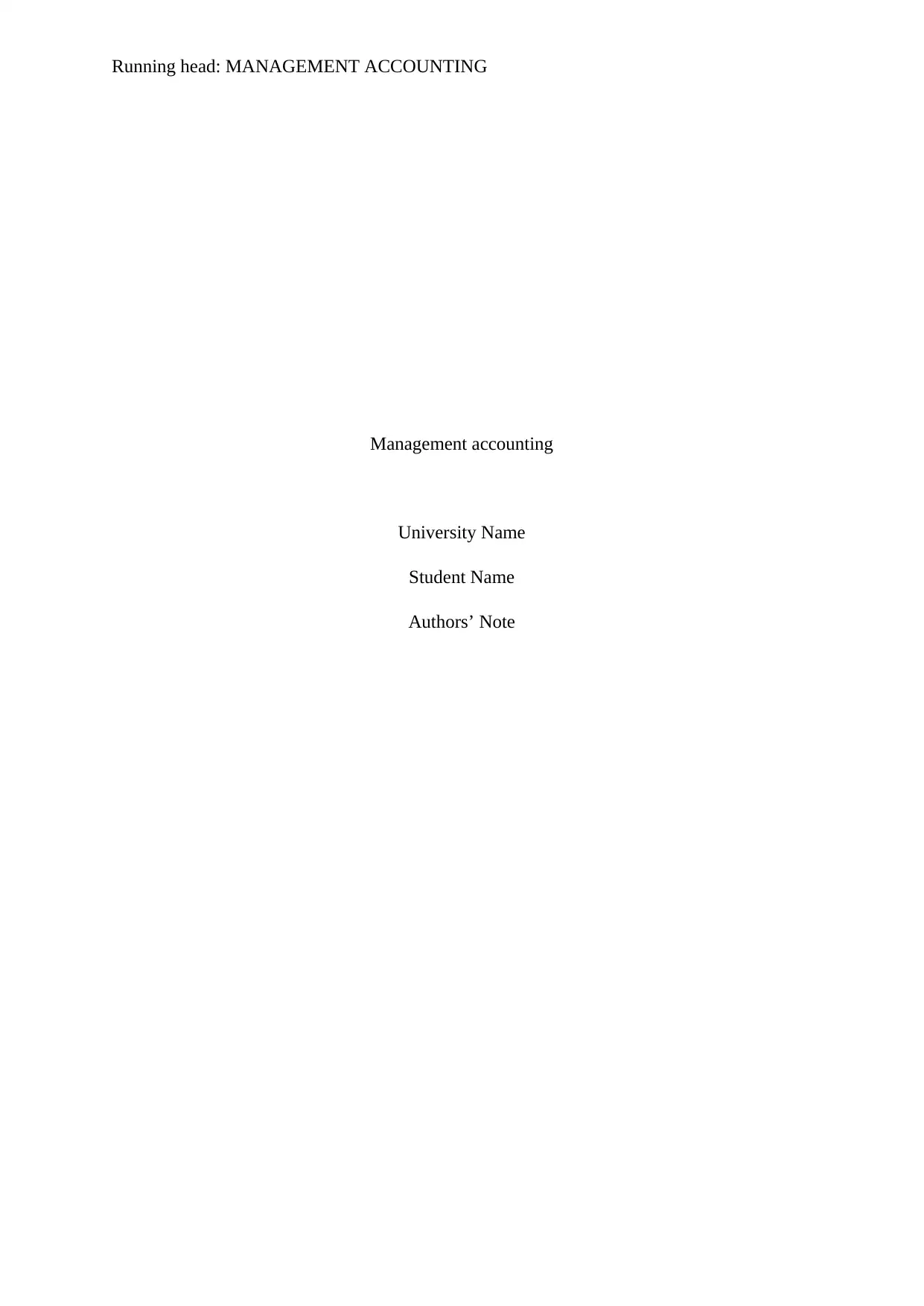
Running head: MANAGEMENT ACCOUNTING
Management accounting
University Name
Student Name
Authors’ Note
Management accounting
University Name
Student Name
Authors’ Note
Paraphrase This Document
Need a fresh take? Get an instant paraphrase of this document with our AI Paraphraser
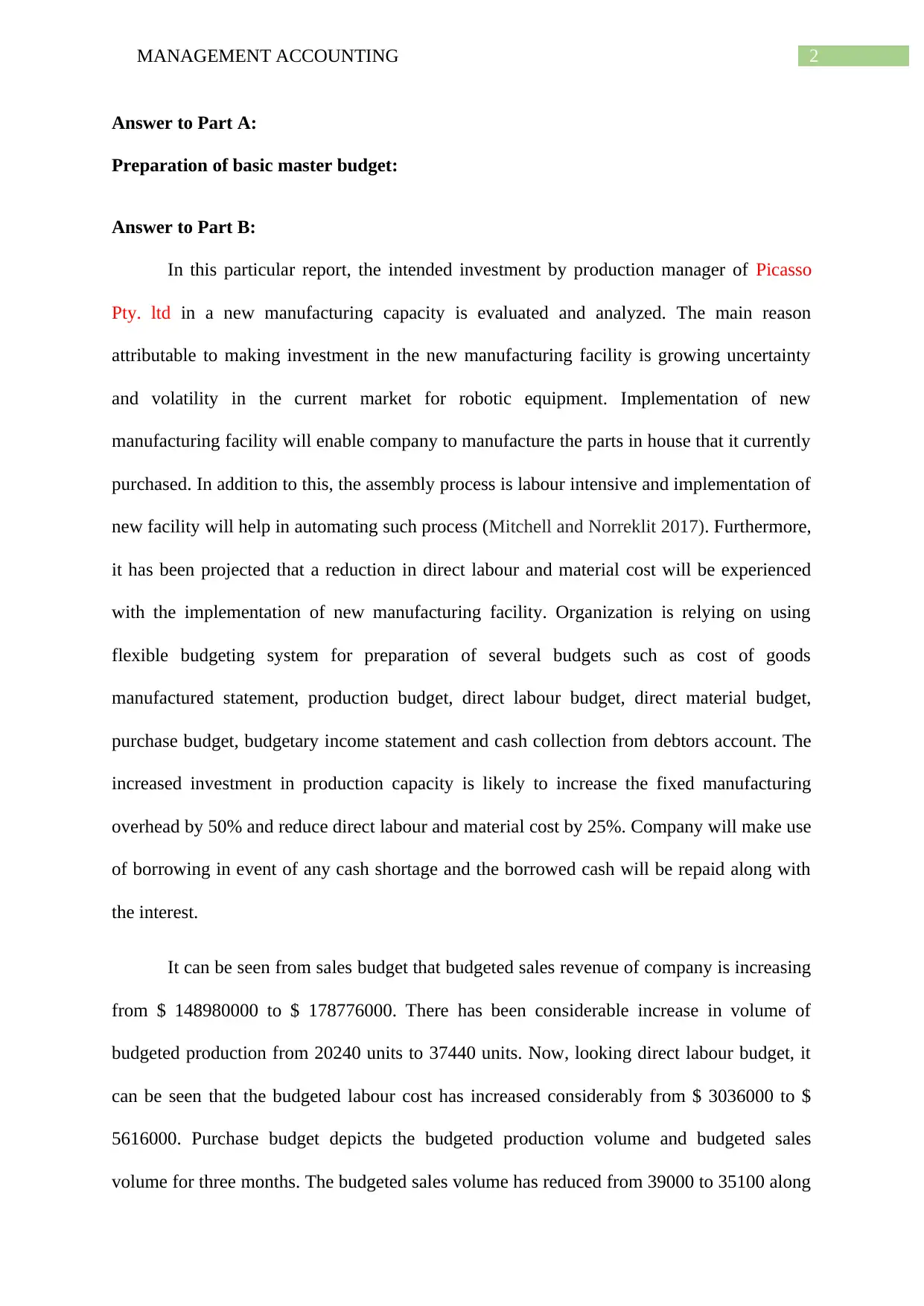
2MANAGEMENT ACCOUNTING
Answer to Part A:
Preparation of basic master budget:
Answer to Part B:
In this particular report, the intended investment by production manager of Picasso
Pty. ltd in a new manufacturing capacity is evaluated and analyzed. The main reason
attributable to making investment in the new manufacturing facility is growing uncertainty
and volatility in the current market for robotic equipment. Implementation of new
manufacturing facility will enable company to manufacture the parts in house that it currently
purchased. In addition to this, the assembly process is labour intensive and implementation of
new facility will help in automating such process (Mitchell and Norreklit 2017). Furthermore,
it has been projected that a reduction in direct labour and material cost will be experienced
with the implementation of new manufacturing facility. Organization is relying on using
flexible budgeting system for preparation of several budgets such as cost of goods
manufactured statement, production budget, direct labour budget, direct material budget,
purchase budget, budgetary income statement and cash collection from debtors account. The
increased investment in production capacity is likely to increase the fixed manufacturing
overhead by 50% and reduce direct labour and material cost by 25%. Company will make use
of borrowing in event of any cash shortage and the borrowed cash will be repaid along with
the interest.
It can be seen from sales budget that budgeted sales revenue of company is increasing
from $ 148980000 to $ 178776000. There has been considerable increase in volume of
budgeted production from 20240 units to 37440 units. Now, looking direct labour budget, it
can be seen that the budgeted labour cost has increased considerably from $ 3036000 to $
5616000. Purchase budget depicts the budgeted production volume and budgeted sales
volume for three months. The budgeted sales volume has reduced from 39000 to 35100 along
Answer to Part A:
Preparation of basic master budget:
Answer to Part B:
In this particular report, the intended investment by production manager of Picasso
Pty. ltd in a new manufacturing capacity is evaluated and analyzed. The main reason
attributable to making investment in the new manufacturing facility is growing uncertainty
and volatility in the current market for robotic equipment. Implementation of new
manufacturing facility will enable company to manufacture the parts in house that it currently
purchased. In addition to this, the assembly process is labour intensive and implementation of
new facility will help in automating such process (Mitchell and Norreklit 2017). Furthermore,
it has been projected that a reduction in direct labour and material cost will be experienced
with the implementation of new manufacturing facility. Organization is relying on using
flexible budgeting system for preparation of several budgets such as cost of goods
manufactured statement, production budget, direct labour budget, direct material budget,
purchase budget, budgetary income statement and cash collection from debtors account. The
increased investment in production capacity is likely to increase the fixed manufacturing
overhead by 50% and reduce direct labour and material cost by 25%. Company will make use
of borrowing in event of any cash shortage and the borrowed cash will be repaid along with
the interest.
It can be seen from sales budget that budgeted sales revenue of company is increasing
from $ 148980000 to $ 178776000. There has been considerable increase in volume of
budgeted production from 20240 units to 37440 units. Now, looking direct labour budget, it
can be seen that the budgeted labour cost has increased considerably from $ 3036000 to $
5616000. Purchase budget depicts the budgeted production volume and budgeted sales
volume for three months. The budgeted sales volume has reduced from 39000 to 35100 along
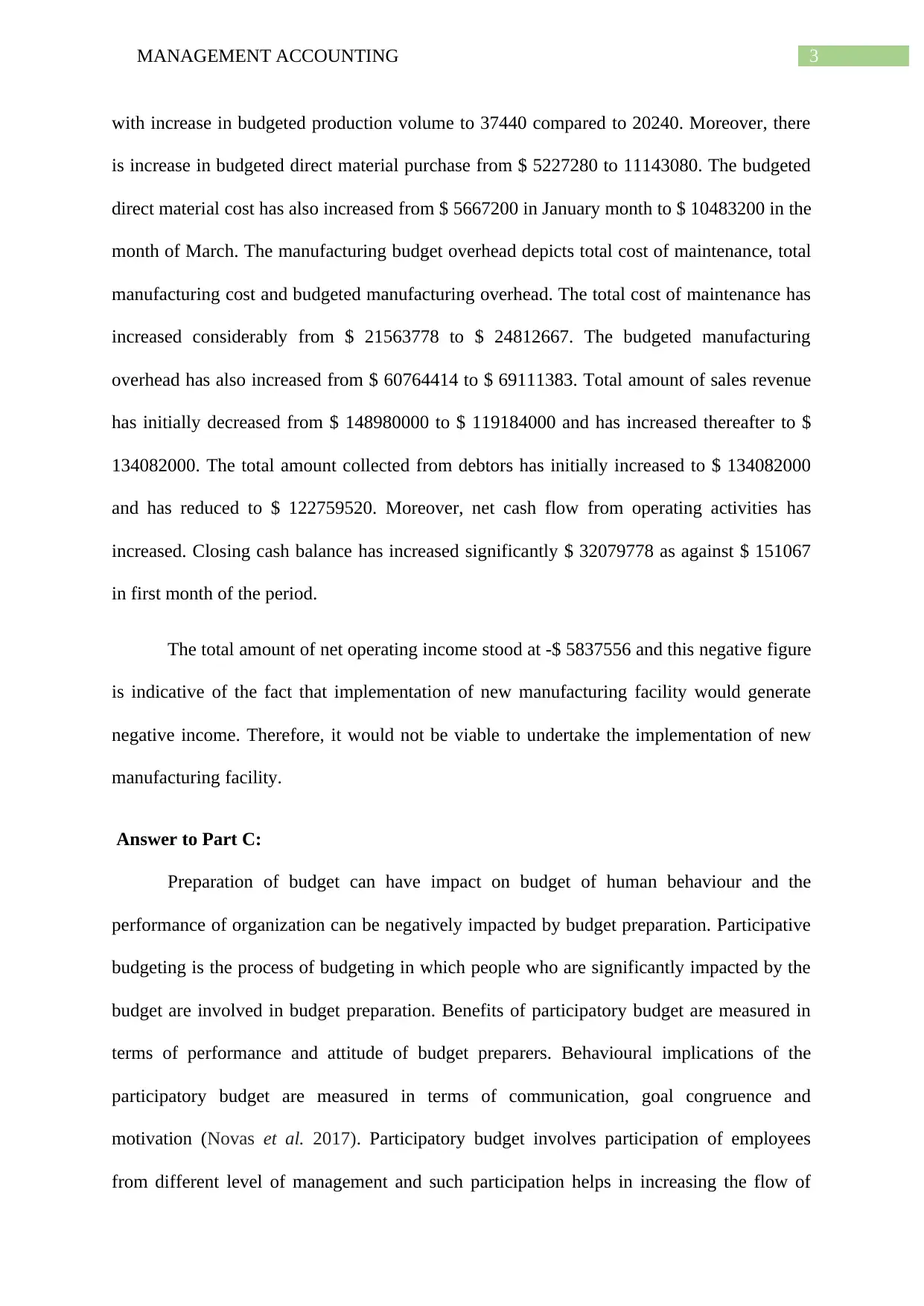
3MANAGEMENT ACCOUNTING
with increase in budgeted production volume to 37440 compared to 20240. Moreover, there
is increase in budgeted direct material purchase from $ 5227280 to 11143080. The budgeted
direct material cost has also increased from $ 5667200 in January month to $ 10483200 in the
month of March. The manufacturing budget overhead depicts total cost of maintenance, total
manufacturing cost and budgeted manufacturing overhead. The total cost of maintenance has
increased considerably from $ 21563778 to $ 24812667. The budgeted manufacturing
overhead has also increased from $ 60764414 to $ 69111383. Total amount of sales revenue
has initially decreased from $ 148980000 to $ 119184000 and has increased thereafter to $
134082000. The total amount collected from debtors has initially increased to $ 134082000
and has reduced to $ 122759520. Moreover, net cash flow from operating activities has
increased. Closing cash balance has increased significantly $ 32079778 as against $ 151067
in first month of the period.
The total amount of net operating income stood at -$ 5837556 and this negative figure
is indicative of the fact that implementation of new manufacturing facility would generate
negative income. Therefore, it would not be viable to undertake the implementation of new
manufacturing facility.
Answer to Part C:
Preparation of budget can have impact on budget of human behaviour and the
performance of organization can be negatively impacted by budget preparation. Participative
budgeting is the process of budgeting in which people who are significantly impacted by the
budget are involved in budget preparation. Benefits of participatory budget are measured in
terms of performance and attitude of budget preparers. Behavioural implications of the
participatory budget are measured in terms of communication, goal congruence and
motivation (Novas et al. 2017). Participatory budget involves participation of employees
from different level of management and such participation helps in increasing the flow of
with increase in budgeted production volume to 37440 compared to 20240. Moreover, there
is increase in budgeted direct material purchase from $ 5227280 to 11143080. The budgeted
direct material cost has also increased from $ 5667200 in January month to $ 10483200 in the
month of March. The manufacturing budget overhead depicts total cost of maintenance, total
manufacturing cost and budgeted manufacturing overhead. The total cost of maintenance has
increased considerably from $ 21563778 to $ 24812667. The budgeted manufacturing
overhead has also increased from $ 60764414 to $ 69111383. Total amount of sales revenue
has initially decreased from $ 148980000 to $ 119184000 and has increased thereafter to $
134082000. The total amount collected from debtors has initially increased to $ 134082000
and has reduced to $ 122759520. Moreover, net cash flow from operating activities has
increased. Closing cash balance has increased significantly $ 32079778 as against $ 151067
in first month of the period.
The total amount of net operating income stood at -$ 5837556 and this negative figure
is indicative of the fact that implementation of new manufacturing facility would generate
negative income. Therefore, it would not be viable to undertake the implementation of new
manufacturing facility.
Answer to Part C:
Preparation of budget can have impact on budget of human behaviour and the
performance of organization can be negatively impacted by budget preparation. Participative
budgeting is the process of budgeting in which people who are significantly impacted by the
budget are involved in budget preparation. Benefits of participatory budget are measured in
terms of performance and attitude of budget preparers. Behavioural implications of the
participatory budget are measured in terms of communication, goal congruence and
motivation (Novas et al. 2017). Participatory budget involves participation of employees
from different level of management and such participation helps in increasing the flow of
⊘ This is a preview!⊘
Do you want full access?
Subscribe today to unlock all pages.

Trusted by 1+ million students worldwide
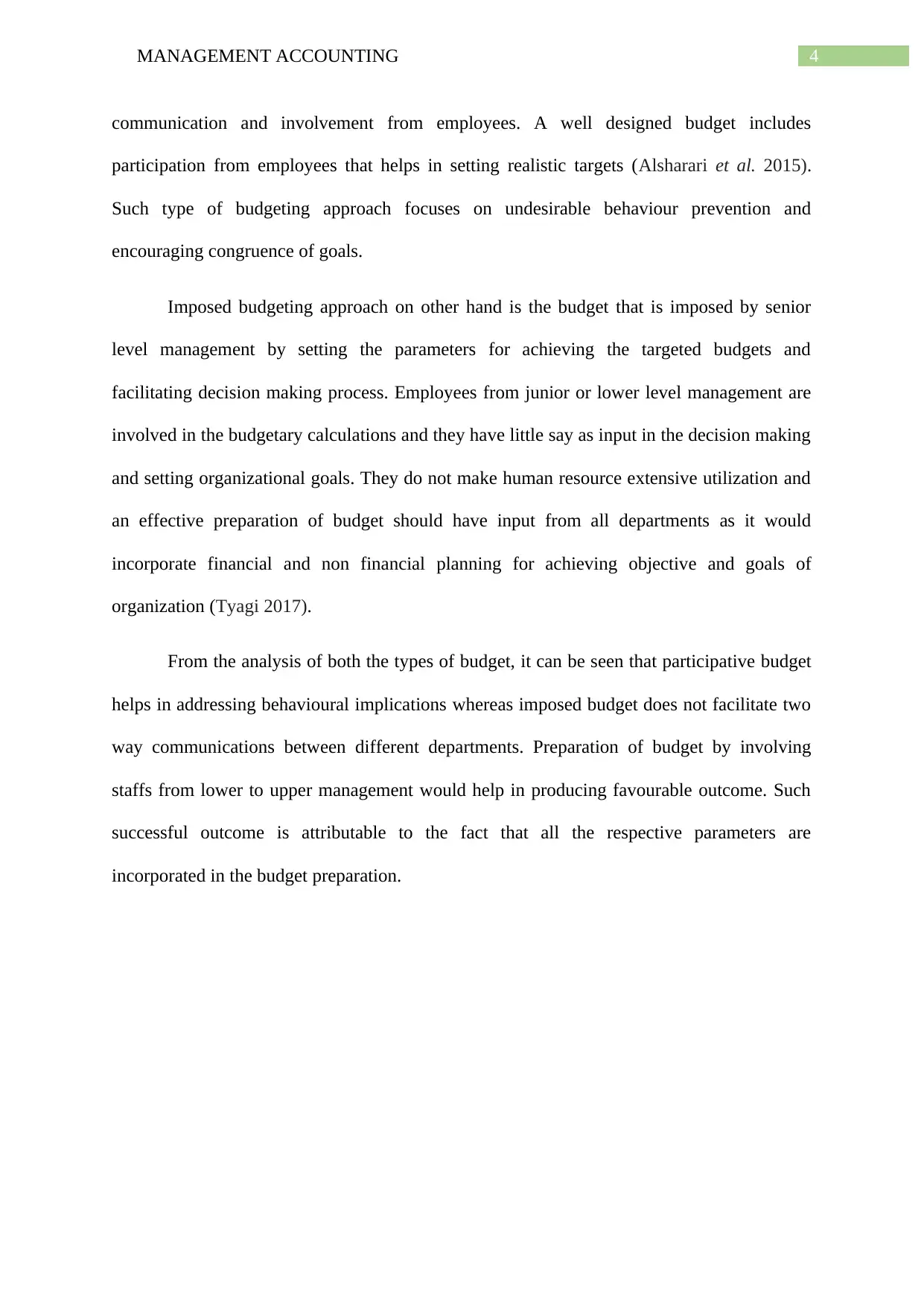
4MANAGEMENT ACCOUNTING
communication and involvement from employees. A well designed budget includes
participation from employees that helps in setting realistic targets (Alsharari et al. 2015).
Such type of budgeting approach focuses on undesirable behaviour prevention and
encouraging congruence of goals.
Imposed budgeting approach on other hand is the budget that is imposed by senior
level management by setting the parameters for achieving the targeted budgets and
facilitating decision making process. Employees from junior or lower level management are
involved in the budgetary calculations and they have little say as input in the decision making
and setting organizational goals. They do not make human resource extensive utilization and
an effective preparation of budget should have input from all departments as it would
incorporate financial and non financial planning for achieving objective and goals of
organization (Tyagi 2017).
From the analysis of both the types of budget, it can be seen that participative budget
helps in addressing behavioural implications whereas imposed budget does not facilitate two
way communications between different departments. Preparation of budget by involving
staffs from lower to upper management would help in producing favourable outcome. Such
successful outcome is attributable to the fact that all the respective parameters are
incorporated in the budget preparation.
communication and involvement from employees. A well designed budget includes
participation from employees that helps in setting realistic targets (Alsharari et al. 2015).
Such type of budgeting approach focuses on undesirable behaviour prevention and
encouraging congruence of goals.
Imposed budgeting approach on other hand is the budget that is imposed by senior
level management by setting the parameters for achieving the targeted budgets and
facilitating decision making process. Employees from junior or lower level management are
involved in the budgetary calculations and they have little say as input in the decision making
and setting organizational goals. They do not make human resource extensive utilization and
an effective preparation of budget should have input from all departments as it would
incorporate financial and non financial planning for achieving objective and goals of
organization (Tyagi 2017).
From the analysis of both the types of budget, it can be seen that participative budget
helps in addressing behavioural implications whereas imposed budget does not facilitate two
way communications between different departments. Preparation of budget by involving
staffs from lower to upper management would help in producing favourable outcome. Such
successful outcome is attributable to the fact that all the respective parameters are
incorporated in the budget preparation.
Paraphrase This Document
Need a fresh take? Get an instant paraphrase of this document with our AI Paraphraser
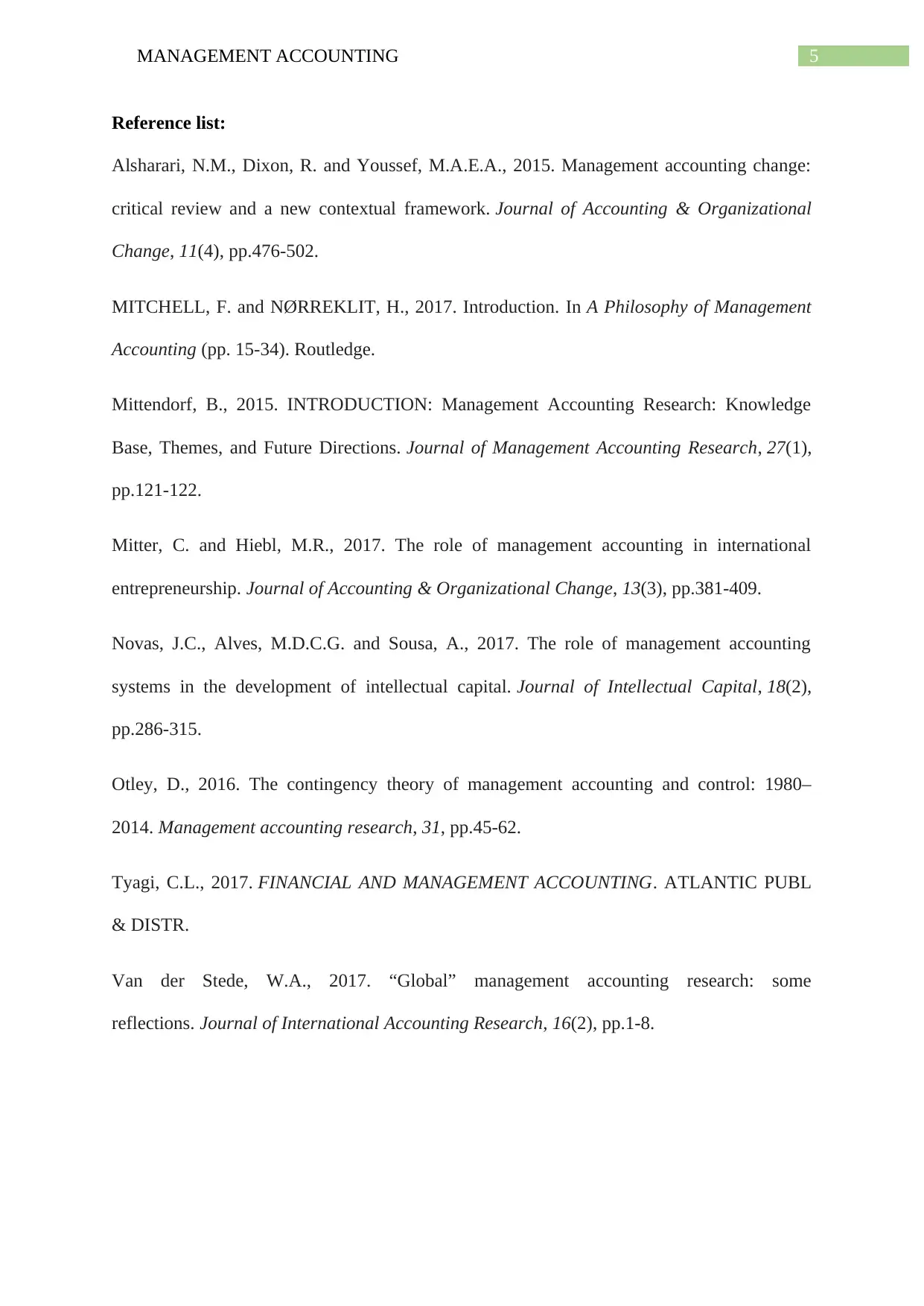
5MANAGEMENT ACCOUNTING
Reference list:
Alsharari, N.M., Dixon, R. and Youssef, M.A.E.A., 2015. Management accounting change:
critical review and a new contextual framework. Journal of Accounting & Organizational
Change, 11(4), pp.476-502.
MITCHELL, F. and NØRREKLIT, H., 2017. Introduction. In A Philosophy of Management
Accounting (pp. 15-34). Routledge.
Mittendorf, B., 2015. INTRODUCTION: Management Accounting Research: Knowledge
Base, Themes, and Future Directions. Journal of Management Accounting Research, 27(1),
pp.121-122.
Mitter, C. and Hiebl, M.R., 2017. The role of management accounting in international
entrepreneurship. Journal of Accounting & Organizational Change, 13(3), pp.381-409.
Novas, J.C., Alves, M.D.C.G. and Sousa, A., 2017. The role of management accounting
systems in the development of intellectual capital. Journal of Intellectual Capital, 18(2),
pp.286-315.
Otley, D., 2016. The contingency theory of management accounting and control: 1980–
2014. Management accounting research, 31, pp.45-62.
Tyagi, C.L., 2017. FINANCIAL AND MANAGEMENT ACCOUNTING. ATLANTIC PUBL
& DISTR.
Van der Stede, W.A., 2017. “Global” management accounting research: some
reflections. Journal of International Accounting Research, 16(2), pp.1-8.
Reference list:
Alsharari, N.M., Dixon, R. and Youssef, M.A.E.A., 2015. Management accounting change:
critical review and a new contextual framework. Journal of Accounting & Organizational
Change, 11(4), pp.476-502.
MITCHELL, F. and NØRREKLIT, H., 2017. Introduction. In A Philosophy of Management
Accounting (pp. 15-34). Routledge.
Mittendorf, B., 2015. INTRODUCTION: Management Accounting Research: Knowledge
Base, Themes, and Future Directions. Journal of Management Accounting Research, 27(1),
pp.121-122.
Mitter, C. and Hiebl, M.R., 2017. The role of management accounting in international
entrepreneurship. Journal of Accounting & Organizational Change, 13(3), pp.381-409.
Novas, J.C., Alves, M.D.C.G. and Sousa, A., 2017. The role of management accounting
systems in the development of intellectual capital. Journal of Intellectual Capital, 18(2),
pp.286-315.
Otley, D., 2016. The contingency theory of management accounting and control: 1980–
2014. Management accounting research, 31, pp.45-62.
Tyagi, C.L., 2017. FINANCIAL AND MANAGEMENT ACCOUNTING. ATLANTIC PUBL
& DISTR.
Van der Stede, W.A., 2017. “Global” management accounting research: some
reflections. Journal of International Accounting Research, 16(2), pp.1-8.
1 out of 5
Related Documents
Your All-in-One AI-Powered Toolkit for Academic Success.
+13062052269
info@desklib.com
Available 24*7 on WhatsApp / Email
![[object Object]](/_next/static/media/star-bottom.7253800d.svg)
Unlock your academic potential
Copyright © 2020–2025 A2Z Services. All Rights Reserved. Developed and managed by ZUCOL.





